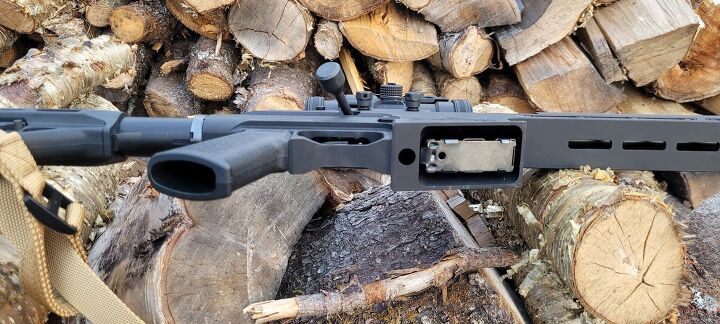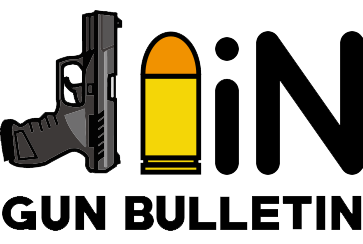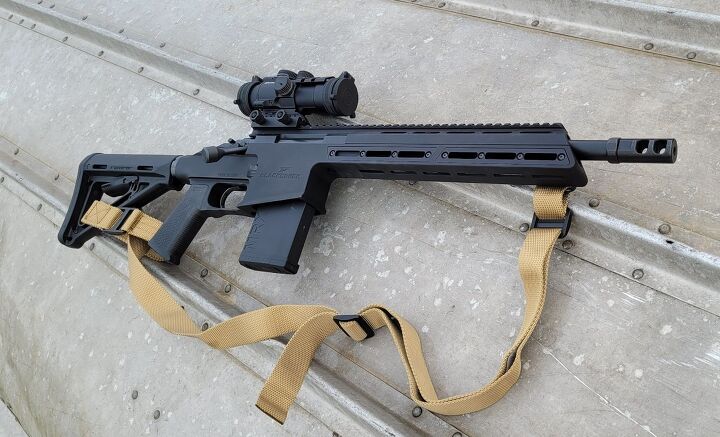Firearms are tools, the hero Shane points out in the 1953 Western drama of the same name. And sometimes, it’s handy to have a specialty tool—a shotgun that’s made to be dragged through thick brush in pursuit of partridge. A pistol that’s made to stop a charging bear dead in its tracks. Or, in the case of the MRX Bison Scout carbine from Black Creek Labs, a rifle that’s compact and easy to transport, with many of the useful features of an AR-pattern firearm, but in a bolt-action format that leaves you less likely to be hassled by The Man.

Canadian firearms @ TFB:
Black Creek Labs: The basic details
Black Creek Labs is a Canadian manufacturer of rifles and pistols. Due to the ongoing fluctuations in Canadian firearms law, not all of their products are currently available for civilian customers in that country. The products that are available in Canada are carefully designed to fit into their restrictions.

This is the reason behind the not-an-AR design of the SRV2 Siberian and SRV2 Grizzly semi-automatic rifles, which use an action designed in-house. This allows Black Creek Labs to sell rifles that are not directly affected by the current Liberal government’s ban on AR-pattern rifles.
Black Creek Labs also sells a range of bolt-action rifles with many features you’d expect on an AR or similar rifle, and parts compatibility with AR rifles, including grips, stocks and more. You can see our previous coverage of these rifles here.
The MRX Bison Scout is part of that range of bolt-action rifles. I purchased one a few months ago to assess its usefulness; here’s what I found out about the rifle.

A solid piece of equipment
I was looking for a rifle that was easily transported on an ATV or motorcycle, so I opted for the MRX Bison Scout with a 12.5-inch barrel (there’s also a version with a 16.5-inch barrel). Mine is chambered in 5.56 NATO, but the Bison Scout also comes in 7.62×39 and 300 Blackout.
The 5.56 NATO variant comes with a 1:8 barrel twist rate; a muzzle brake is at the end of the barrel. With this barrel length, Black Creek Labs guarantees a 1.5 MOA standard at 100 yards with all these chamberings, if using quality ammunition.
This rifle is built around Black Creek Labs’ proprietary three-lug MRX Supershort action, with a 60-degree throw. The receiver is made of AISI 4140 steel. The action sits in a Type III Class 2 hard-anodized monolithic 6061– T6 aluminum chassis that gives the rifle a solid feel, despite its small size—the claimed weight for this version of the rifle is 6.9 pounds. On this carbine, a full-length Picatinny rail runs the length of the barrel, with M-LOK slots cut into the sides of the chassis’ forend, and underneath. This means there’s a lot of room to attach a light, optics, foregrip, whatever you need. There’s also a QD mounting hole on the receiver, forend and stock.


Speaking of the stock, this is one of several parts that Black Creek Labs has opted to source from a third-party manufacturer. Magpul provided a collapsible MOE stock and MOE K grip, and this was the very first thing I noticed that I didn’t like about the rifle. The stock is just too wobbly for my liking. I could have easily swapped it out for something else since it attaches the same as any other standard AR-pattern stock and you don’t even have a buffer tube to worry about. But because I’m frugal and because I figured another folder or collapsible stock would probably offer little improvement, I simply used foam tape to tighten up the stock’s sliding action, and it’s solid now.
Black Creek Labs also outsourced the trigger. The MRX Bison Scout uses a TriggerTech Primary, originally designed for the Remington 700. It’s adjustable, from 2.5 to 5 pounds pull.
The safety is on the right-hand side of the receiver, with no markings to indicate what the Safe or Fire positions are. The bolt release button is on the top of the left-hand side of the receiver, and the mag release is on the right-hand side. This is not anywhere close to being an ambidextrous gun.
The final noteworthy point of design and construction is the rifle’s magazines. It’s made to accept AR-pattern magazines since that’s the standard in the firearms world. But due to confusing and nonsensical magazine capacity laws, this means that Canadian shooters are therefore restricted to a five-round capacity if they’re using AR rifle magazines, or a 10-round capacity if they’re using pistol magazines that just happen to fit into the rifle (remember, I said it makes no sense). So, Black Creek Labs came up with their proprietary 20-round MRX Magazine.
The MRX Magazine only fits the Supershort action; it will not fit into an AR15 or any of the many AR180B-pattern rifles that are circulating around Canada. Because Canada currently has no restrictions on magazine capacity for bolt-action rifles, Black Creek Labs can sell 20-rounders for its MRX Bison with no legal issues. This is the highest-capacity centerfire rifle that most people can readily find in the Great White North.
Shortly after buying my MRX Bison, I also purchased an MRX Magazine to go with it, along with a five-round AR mag, a P-Mag that was pinned to only hold five rounds, and a couple of LAR-15 mags with a 10-round capacity. I mounted a cheap red dot, the only optic I had lying around that was remotely suited to the rifle and went to the range.

Shooting the MRX Bison
I wasn’t sure what to expect at the range, because Black Creek Labs is like most other Canadian firearms manufacturers—they have a reputation for letting their customers function as quality control testers, and working out the final bugs in production. I am not saying that this reputation is fair, but that is the reputation nevertheless, and it’s partly why I opted for a bolt-action instead of a made-in-Canada semi-auto. A bolt-action design is pretty hard to mess up. Nevertheless, note that Black Creek Labs did offer an updated ejector for this rifle after a few months of production, and some customers also got a new barrel installed when they couldn’t get the accuracy they expected.
My first range visit ended when I decided it was pointless to keep banging away with that cheap red dot mounted, but I did learn a few things about the rifle. I was very happy with the SuperShort action itself; it’s smooth and slick to operate. It’s true that ejection wasn’t particularly strong, but I think this is mostly due to me not reefing on the bolt handle. I do have an upgraded ejector I could install if I thought it was a problem, but from my perspective, it isn’t. Remember that all new Bison rifles and carbines would come with the updated ejector installed from the factory anyway.

The rifle also fed well from all the magazines I brought, but I found the longer LAR-15 mags were a bit rattly in the magwell; an application of electrical tape solved that problem. And the 20-round MRX Magazine did feed well, but at first, the plastic made-in-Canada mag was a bit sticky to get in and out of the rifle. Once in the rifle, when you start blasting away, you realize why 20-round magazines aren’t a big thing in the bolt-action world to start with. If you were using this rifle for some sort of tactical shooting competition, I could see why you might want the extra capacity. But for most other shooting, even for plinking, it’s a gimmick more than it’s useful.
Recoil is minimal. Not that you’d expect a stiff kick from a .223 anyway, but the muzzle brake reduces it to nothing. This is a very easy rifle to shoot, and one bonus of the collapsible stock is that you could easily teach a smaller-statured person to shoot with this rifle. Just don’t do it with a cheap red dot like I did.

Later, I mounted a Vortex Gen II 3x prism scope to the Bison; an LPVO or standard hunting scope might have been a better choice, but I wanted to try something compact, so I could easily haul this rifle in an ATV storage box or something similar.
Accuracy was much better with the Vortex scope, and much better when I switched from El Cheapo 55-grain hollowpoints (possibly sitting in my locker since pre-COVID) to better-quality 50-grain Sako softpoints and then Federal Fusion 62-grain deer-hunting loads. Did I get the 1.5 MOA accuracy that Black Creek Labs promises? No, but I think with a higher-power scope and a better shooter (I’m wayyyy out of practice these days), then you could get pretty close. You might have to switch out a few brands of ammo to find something that works, and 1.5 MOA isn’t exactly the stuff they dream of over at the Sniper’s Hide forum. But for a utility gun, fulfilling the role that a lever-action rifle used to hold down on a ranch or farm, it will be fine if you put some work into learning the rifle’s true capabilities.

Conclusion
I’m happy with my rifle and think it’s got potential to be very useful in the years ahead, although I do wonder if I might have been happier with the 7.62×39 version with the longer 16.5-inch barrel.
I’m glad I haven’t had any quality issues with the rifle so far, and based on what I’ve observed with Black Creek Labs over the past couple of years, I think they’d take care of me if I did have problems. I still am not convinced it’s time to run out and buy one of their semi-autos, but if I continue to have a trouble-free existence with the Bison, it might be time to try a Siberian next.
Until then, I’m happy to keep exploring the potential of the Bison as a general-purpose rifle, including some hunting scenarios where its compact size makes it useful. Like I said at the start, it’s a niche rifle.
Even if you live in a jurisdiction where semi-auto rifles are easier to get than in Canada, I could see this rifle still having value for some shooters due to its unique blend of a bolt action with an AR-style layout—particularly if you’re interested in equipping a rifle with a silencer.

The MRX Bison’s bolt-action design makes it able to cycle subsonic ammunition without any modification. If you want the function of a suppressor, but you also want the collapsible stock, AR-style controls and a chassis that accepts a wide range of accessories, the MRX Bison could possibly fill the bill, since it comes pre-threaded for a muzzle device.
Unbolt the gilled brake, and you’ll see the barrel ends with 1/2-28″ threads. Heading over to Silencer Shop, they’ve got a lot of stuff that will bolt right up. For me, I’d be looking at something like the Dead Air Sierra 5 with the Xeno adapter. This version of the Sierra 5 is only 5.72 inches long, which would perhaps better fit the bill if you’re putting it on a short-barreled rifle. It would be my choice, because in the confines of a hunting blind, I’m not worried about weight, I’m worried about maneuverability and my hearing. The same thing applies if I’m pushing through a woods thicket while chasing game; I don’t want an awkwardly long can on the end. The Dead Air Sierra 5 is priced at $699 at Silencer Shop.
Dead Air Sierra 5 Silencer

Obviously, your choice comes down to your individual usage case—take a look at Silencer Shop’s range of 5.56-tuned suppressors, and you can find something that works for you. But if it was me, I’d be looking to fit a stubby can onto this rifle if I lived in a jurisdiction that allowed it. It would make it even better for the kind of close-in woods hunting that I’ll probably use this rifle for in the years to come, with no worries about my eardrums being blasted by the muzzle brake that’s currently installed.
MSRP for the MRX Bison is not listed on Black Creek Labs’ website, but you can find other details on the firearm there if you want more info.
TFB is proud to partner with Silencer Shop as our preferred vendor for all of your NFA needs. Whether you are searching for a new suppressor, SBR, or trust, Silencer Shop is here to provide a seamless and fast service for your next NFA purchase. Head over to www.silencershop.com to begin your NFA journey.


